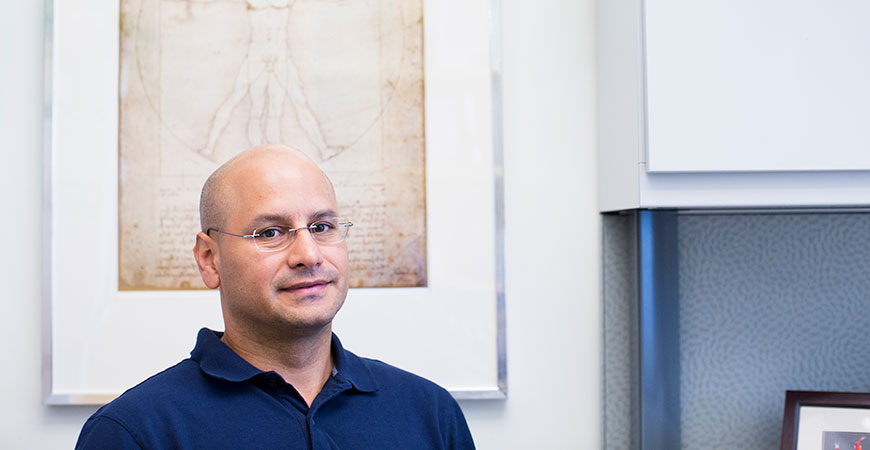
The same cellular renewal that keeps our bodies healthy might also fuel the growth of cancer. A UC Merced biologist has found that the brain could hold the key to stopping it.
Professor Néstor Oviedo, a molecular and cell biologist and affiliate of the Health Sciences Research Institute, received more than $2 million from the National Institutes of Health to investigate signals mediating the earliest stages of cancer development. His findings could one day change how doctors think about treating cancer and age-related diseases.
“Our initial data suggest that key cancer symptoms can be selectively removed by activating signals from the nervous system,” Oviedo said. “In other words, by turning down brain molecular switches, we can control cancer.”
The five-year project, funded through the NIH’s National Institute of General Medical Sciences, focuses on a biological paradox: The same cell-renewal processes that keep tissues functioning also create endless opportunities for mutations to occur. Every day, the body replaces billions of cells, but with each division comes a chance for error.
That constant renewal is one reason more than 90% of human cancers begin in epithelial tissues, such as the skin or the lining of the gut — places where cells are replaced most frequently.
“Understanding how cancer emerges during this renewal process is extremely challenging,” Oviedo said. “Different tissues regenerate at different speeds, and the signals they receive from surrounding tissues can profoundly influence how cells behave.”
One of the earliest steps in cancer development is DNA damage, particularly double-strand breaks — the most dangerous type. But scientists still don’t fully understand how some damaged cells manage to survive, multiply and become tumors.
A Simple Organism, a Powerful Model
 To tackle that question, Oviedo and his lab turned to an unlikely organism: planarian flatworms. These small, freshwater worms are famous for their regenerative abilities — cut one in half, and it can grow into two complete animals.
To tackle that question, Oviedo and his lab turned to an unlikely organism: planarian flatworms. These small, freshwater worms are famous for their regenerative abilities — cut one in half, and it can grow into two complete animals.
Planarians owe that regenerative power to their stem cells, called neoblasts, which can become any cell type in the body. Oviedo’s lab has spent years developing genetic tools to study how these cells behave — making planarians a surprisingly powerful model for understanding cancer.
By disrupting a tumor-suppressing gene known as PTEN — one of the most frequently inactivated genes in human cancers — the researchers can trigger a cancer-like condition in planarians within just 12 days.
“It was fascinating to see many traits of cancer evolution develop in less than two weeks,” Oviedo said. “Other models take much longer and are far more costly. The planarian model lets us induce cancer-like symptoms and track, in real time, how normal cells transition to cancerous ones.”
The changes were dramatic. Shortly after PTEN disruption, the worms showed unchecked cell growth, tissue invasion and tumor-like formations — all hallmarks of cancer.
Neural Signals That Stop Cancer
Then came the surprise: When the team interfered with neural signals, the worms’ cancer-like symptoms began to disappear.
“Remarkably, by altering communication between the nervous system and stem cells, we could suppress these cancer traits,” Oviedo said. “That finding opened an entirely new area of investigation — one where the brain itself may play a protective role against cancer.”
This discovery could help explain why some tissues are more prone to cancer than others and how stress, aging or neurological health might influence cancer risk.
The research team will now combine genetic, cellular and genomic analyses to study how damaged stem cells survive and proliferate, and how neural pathways might control that process.
“It’s still too early to apply these findings clinically,” Oviedo said. “But we expect to begin testing them soon in mammalian cancer models. To my knowledge, this is the first evidence showing that modulation of neural signals can specifically eliminate cancer cells without affecting normal cells.”
Beyond Cancer
While cancer remains the focus, Oviedo’s work could also shed light on degenerative diseases linked to aging, which may share underlying mechanisms with cancer.
“Many age-related conditions might be affected by DNA changes that can be targeted by disrupting specific neural signals,” Oviedo said. “We believe this approach could eventually be useful in addressing those conditions as well.”
 In addition to the cancer project, Oviedo’s research group studies how stem cells are regulated during tissue regeneration and how the immune system responds to fungal infections. The new NIH grant will support that broader work, funding staff, graduate students and new experiments through 2030.
In addition to the cancer project, Oviedo’s research group studies how stem cells are regulated during tissue regeneration and how the immune system responds to fungal infections. The new NIH grant will support that broader work, funding staff, graduate students and new experiments through 2030.
The project’s official title — “Mechanisms of Stem Cell Regulation During Tissue Renewal and Cancer Development” — reflects a wide-ranging exploration of life’s most fundamental processes.
From Basic Science to Big Possibilities
For Oviedo, who has long championed basic biological research, the NIH funding affirms the value of studying simple systems to answer complex questions.
“Planarians might seem like an odd choice for cancer research,” he said with a smile. “But nature often hides its best clues in unexpected places. These worms help us see the connections between systems — between regeneration, the nervous system and disease.”
Those connections, he believes, could ultimately reshape how scientists and clinicians approach cancer — not just as a disease of rogue cells, but as a breakdown in the communication networks that normally keep them in check.
“We are committed to understanding the molecular signals involved in this process,” Oviedo said. “If we can learn to restore the body’s natural balance, we may find new ways to prevent or reverse cancer altogether.”
Lorena Anderson

Senior Writer and Public Information Representative
Office: (209) 228-4406
Mobile: (209) 201-6255






